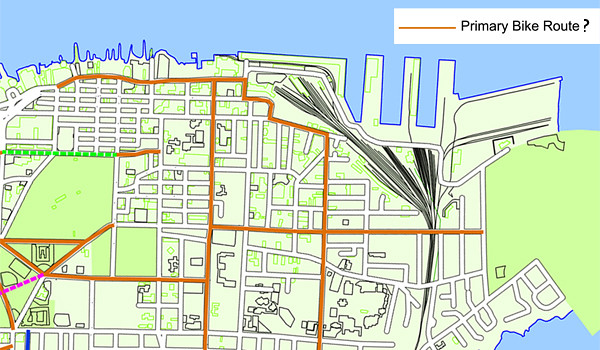
HALIFAX – On September 19, 2011, traffic patterns in Downtown Halifax were altered in an attempt to ease congestion in the city’s core. In this first of three planned phases, a number of streets that currently allow two-way traffic now only permit one-way traffic (including sections of Blowers, Market, Sackville, George, and Granville streets), while a section of Grafton Street will now allow two-way traffic. Subsequent phases in October and March will see Lower Water Street becoming one-way north bound, signals added to the Duke and Lower Water Street intersection, and bike lanes added to both Lower Water and Hollis streets.
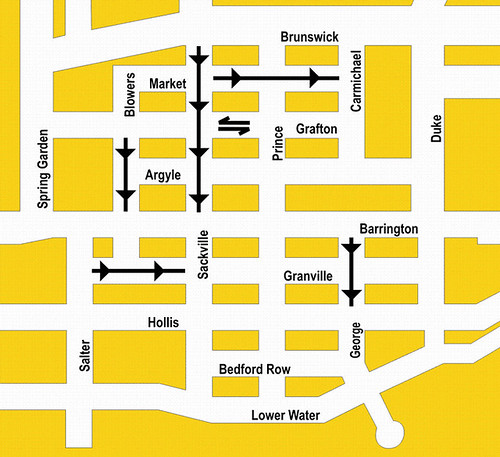
In a report to Council, HRM Staff claim that “the highlight of this plan is the creation of new bike lanes on Hollis Street and Lower Water Street”. Why then does this plan sacrifice the safety of cyclists and efficiency of both its active transportation and public transit network?
In November 2010 HRM Staff released a plan illustrating proposed changes to traffic patterns in Downtown Halifax. This plan illustrated a complete “loop” – a south-bound bike lane on Hollis Street to Terminal Road, providing a connection to both the Halifax Farmer’s Market and NSCAD, and a north-bound bike lane on Lower Water Street to Duke Street, linking the George Street Metro Transit Ferry Terminal entrance and looping back to the south-bound bike lane via Duke Street. However, in the August 2011 update to the plan, two blocks of the bike lane on Lower Water Street disappeared.

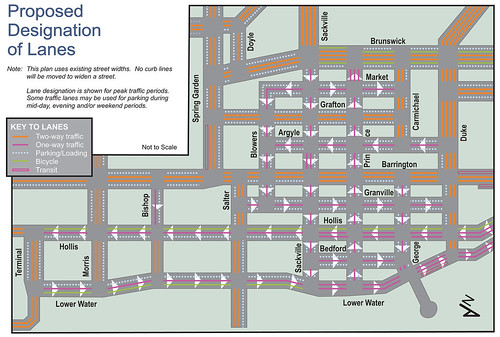
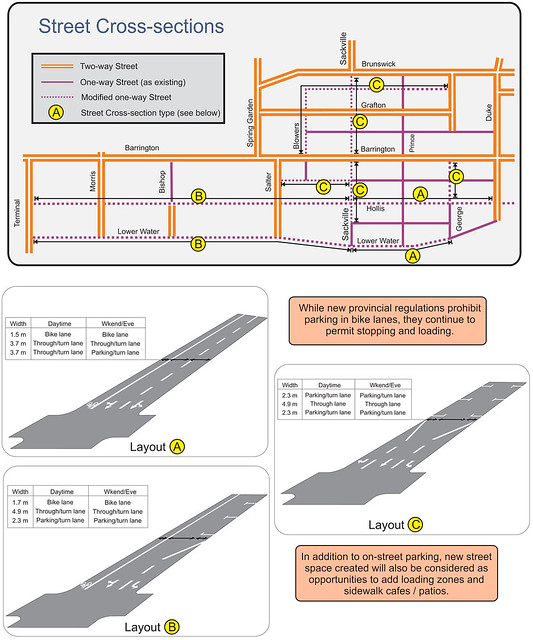
In response to an enquiry, HRM Staff state that while they would prefer to complete the bike lane, “after more detailed survey information was collected as the project proceeded from conceptual through to detailed design, it was found that we actually did not have the sufficient width…and in an ideal world, bicycle infrastructure would terminate at logical destinations, rather than appearing and disappearing randomly, however the challenges of retrofitting an existing city, while balancing all the competing demands on a limited roadway do not always make that possible”. While spatial constraints may be of concern, far more constrained cities have managed to add proper bike lanes to their circulation networks.
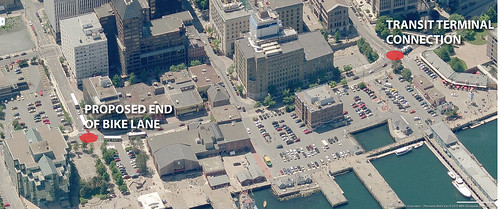
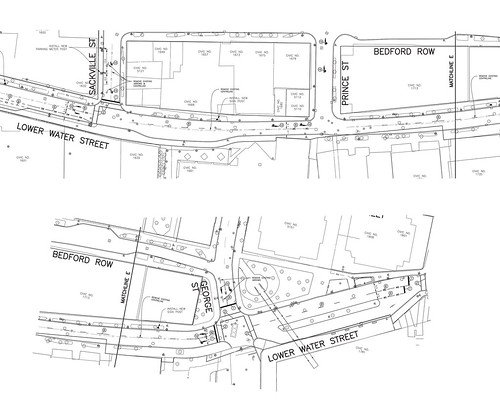
HRM Staff don’t see this discontinuity of the new bike lane as a significant issue as “cyclists can and do leave Lower Water at Prince and use the parking lot corridor to get to the ferry terminal”. But encouraging cyclists to cut along sidewalks, over foot bridges, through parking lots, surely isn’t sound policy, does little to encourage responsible cycling, and arguably discourages cyclists from abiding by regulations as laid out in the Motor Vehicles Act (concerns recently expressed by HRM Regional Police in the media).
As the success of bike lanes is primarily based on connectivity (even the 2002 HRM Bike Plan lists “connectivity” first in a list of 14 criteria for decision making regarding the implementation of bike lanes), justification for removing this short section seems to be lacking. And sacrificing the safety of those who are actively removing themselves from traffic – and doing, a small part, in helping congestion issues – shouldn’t be an option. By ending the Lower Water Street bike lane at Sackville, cyclists will be effectively dumped into two lanes of one-way traffic, as drivers make their way out of the city after work.
While there are spatial limitations “on the ground”, these limitations seem to only ever affect those actually “on the ground”. Ending the bike lane at Sackville Street is sure to result in frequent conflict between drivers and cyclists. In such a situation, if the only option is to end the bike lane abruptly, the addition of the bike lane should be reconsidered.
These proposed changes come at the expense of the safety of both cyclists and pedestrians in what should be one of most the most pedestrian- and cyclist-friendly areas of the city. This extremely short-sighted plan sacrifices the safety of cyclists for the sake of an extra lane (for only two blocks) for motorists and traffic flowing mostly eastbound on Sackville Street. And despite claims by HRM Staff, there is the choice – a very slight increase in road capacity for those vacating the city at 5pm or improved safety for those who actually live in it.
The Lower Water Street changes, including the incomplete bike lane, are expected to be implemented on October 16, 2011.
Images from HRM. While HRM Staff promptly responded to requests for clarification and information, the Councillor for the area did not respond to expressed concerns.

8 comments
With regards to this quote: “By ending the Lower Water Street bike lane at Sackville, cyclists will be effectively dumped into two lanes of one-way traffic, as drivers make their way out of the city after work.” In my opinion i’ve always found that car traffic on one way streets travels at a higher speed. (only opinion, not fact) And we know that there is a direct conection between higher car speeds and safety. That is, it’s less safe for other roads users as cars speed up. So basically this going to make it more dangerous for other road users. HRM seems to want to sacrifice the safety of some citizens for the convenience of others. What they need is a lawsuit forcing them to treat all citizens equally with regards to safety. 🙂 Extreme? Yes but they don’t seem to want to treat the issue of safety seriously on their own. And if this was an issue where road design caused a car collision due to poor design, you can bet their would be a lawsuit by the injured car driver.
The “parking lot corridor” for cyclists is not an acceptable solution…it’s supposed to be developed in the next few years.
The only real bottleneck in that two block segment of Lower Water Street is just south of Prince St, where the buildings on each side might be too close to the road to permit the sidewalks to be shifted or narrowed (see the link at the bottom of this post). Even here, it might be possible to widen the roadway enough to permit the inclusion of a bike lane. Elsewhere along those two blocks, I see no reason why the road can’t be made wide enough for a bike lane.
To go off topic slightly, the first thing that jumped out at me when I saw the proposed street lanes was that there are no east-west bike lanes. Why can’t there be a bike lane on Sackville Street and/or Prince Street to connect the ones running north-south? Are this city’s planners worried that cyclists will go too quickly if there’s a bike lane on a hill, and this could create a safety problem? As you note, connectivity is the key to the success of bike lanes, and the proposed lanes seem doomed to failure (or marginal success) because of their inadequacy in that regard. I hope that the low traffic we’re likely to see in these bike lanes as a result of their poor design won’t provide an argument against adding an east-west bike lane in the future – one that should be included in the current plan anyway.
http://maps.google.com/maps?q=lower+water+st,+halifax,+ns&hl=en&ll=44.647819,-63.571497&spn=0.001362,0.003272&sll=37.0625,-95.677068&sspn=49.043149,107.226563&vpsrc=6&hnear=Lower+Water+St,+Halifax,+Nova+Scotia,+Canada&t=k&z=19&layer=c&cbll=44.647877,-63.571529&panoid=7SY8wTfgUx7dJ-nEP2NEmw&cbp=13,164.91,,0,14.08
“In my opinion i’ve always found that car traffic on one way streets travels at a higher speed.”
This is an important point, Chris. Current conditions on Hollis are a good example of this. I bike Hollis daily and you are constantly squeezed between parked cars and two lanes of southbound traffic. With these changes Lower Water will become a similar high speed corridor for car commuters only.
Lower Water now is a great bike route because of the slower speed of traffic and the greater attention paid by drivers. In general, cyclists and drivers do well at sharing the road. This will surely change when it is one way only.
Rather than use a bike lane that you know will end, I’d encourage cyclists to take the entire lane when the changes occur on Lower Water. HRM is really making this the only safe option. It is often the only safe way to currently bike on Hollis Street.
The city will continue to make up its own rules regardless of how many people want bike lanes. This game is unfair to some, but drivers will probably argue they’ve been hard up with all the traffic and whatnot.
Checkmate. Nothing to be done.
I don’t think bikes can trump cars in such matters, because there aren’t enough commuting cyclists yet. We can get numbers up without public funds or help or infrastructure; just by making cycling a bit more luxurious and driving a bit less. We need to get the suits on our side! How about bike-through coffee stands, and valet bike-parking. I have only been offered valet service once, and that was at the Marriot Waterfront. Man, I felt suave!
When goals are based on relieving congestion, narrowly defined as vehicle speeds, these are the kind of solutions one ends up with. In Toronto we’ve been trying to return one-way streets to their original function, because the speeds of multi-lane one-way streets tend to be unpleasant to cross or walk along and divert transit and business elsewhere.
Richmond/ Adelaide conversion
http://www.thestar.com/News/GTA/article/628981
Hamilton
City councillors have wrong-way thinking on two-way streets
http://quandyfactory.com/essays/23/city_councillors_have_wrong_way_thinking_on_two_way_streets
I’ve never been on Hollis Street when there was a reason not to take a full lane. Either there is little traffic and motorists can drive around you, or there is lots of traffic and it is moving slowly enough that a cyclist can keep up with it. In any case, there is not enough room to ride outside of the lanes on that street, especially if we expect car drivers to follow the 1-metre rule.
whoah this blog is fantastic i really like studying your posts. Stay up the great work! You recognize, a lot of persons are hunting round for this info, you could aid them greatly.